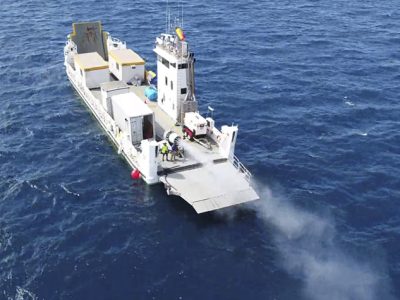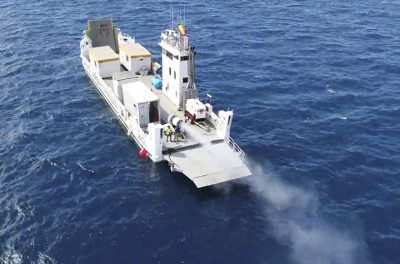 In response to insufficient cuts in greenhouse gas emission, some scientists and others are researching solar geoengineering. These techniques would reflect a small portion of incoming sunlight to cool the planet and counter climate change. A major step in solar geoengineering was recently taken, although you probably wouldn’t know it from reading the news or …
In response to insufficient cuts in greenhouse gas emission, some scientists and others are researching solar geoengineering. These techniques would reflect a small portion of incoming sunlight to cool the planet and counter climate change. A major step in solar geoengineering was recently taken, although you probably wouldn’t know it from reading the news or …
Continue reading "A Solar Geoengineering Milestone Goes Largely Unnoticed"
The post A Solar Geoengineering Milestone Goes Largely Unnoticed appeared first on Legal Planet.
#thenews #theplanet
In response to insufficient cuts in greenhouse gas emission, some scientists and others are researching solar geoengineering. These techniques would reflect a small portion of incoming sunlight to cool the planet and counter climate change. A major step in solar geoengineering was recently taken, although you probably wouldn’t know it from reading the news or following environmental groups.
While solar geoengineering has been the subject of quite some modeling work for well over a decade, a central question has been, “When will meaningful outdoor experiments take place?” One could point to a low-altitude test of aerosols in Russia in 2009, but its substantive value seems limited. And while a 2011 experiment that examined the interactions among aerosols, clouds, and solar radiation was important for the proposed “marine cloud brightening” method of solar geoengineering, it was only later acknowledged as such. What would have been the first explicit and meaningful outdoor solar geoengineering field test was cancelled in 2012 due to irregularities and potential conflict of interest in the review process.
Regardless, the eyes of the interested and concerned have long been on Harvard’s Solar Geoengineering Research Program, which has been planning an outdoor test since about 2012. In 2018, Nature news reported:
If all goes as planned, the Harvard team will be the first in the world to move solar geoengineering out of the lab and into the stratosphere, with a project called the Stratospheric Controlled Perturbation Experiment (SCoPEx)….
the experiment will be the first to fly under the banner of solar geoengineering. And so it is under intense scrutiny, including from some environmental groups, who say such efforts are a dangerous distraction from addressing the only permanent solution to climate change: reducing greenhouse-gas emissions…
“SCoPEx is the first out of the gate, and it is triggering an important conversation about what independent guidance, advice and oversight should look like,” says Peter Frumhoff, chief climate scientist at the Union of Concerned Scientists in Cambridge, Massachusetts, and a member of an independent panel that has been charged with selecting the head of the advisory committee. “Getting it done right is far more important than getting it done quickly.”
As noted, skeptical environmentalists and scientists are concerned about SCoPEx, not because of the direct physical risks — which they acknowledge would be negligible — but largely because of its symbolism. For example, one critical climate scientist calls it “cross[ing] the Rubicon.” As such, they and others call for additional governance of solar geoengineering research.
Indeed, SCoPEx has been investing in ex ante governance. One of its objectives is “To perform the experiments in a manner that exemplifies good governance by developing and implementing norms, mechanisms and practices that can serve as useful templates for possible future solar geoengineering field experiments.” To this end, in 2018 its leadership decided to form an independent Advisory Committee. This necessitated a search committee the dean’s approval. The Advisory Committee was constituted last year.
In March, “the first [experiment] to fly under the banner of solar geoengineering” took place… in Australia. A couple years ago, the Queensland government awarded a few modest grants to protect the Great Barrier Reef, including to two groups that wished to research solar geoengineering for this purpose. One looked at an ultra-thin biodegradable reflective film for the ocean’s surface and the other at brightening marine clouds. The latter project, based at Sydney Institute of Marine Science and Southern Cross University, began its outdoors work, just before the coronavirus regulations came into effect. The federal Australian government subsequently awarded the team an additional grant to continue its efforts.
There are two clear contrasts between Harvard’s SCoPEx and the Queensland marine cloud brightening project. For one thing, the former has (publicly) emphasized governance. Additional measures, such as establishing an independent Advisory Committee and greater public communications, have contributed to the project’s extended timeline. On the other hand, the latter went from grant to field test in less than two years. I am unaware of any additional dedicated governance measures there. The Queensland-funded team consists only of engineers and scientists, with no social scientists or humanities scholars. And the only public information was a paragraph from the Queensland government (removed within a year) and a minimal website.
For another thing, the Harvard project has generated abundant media coverage and attention from critical environmental activist groups. When it goes forward, I expect another large round of this. In contrast, the Great Barrier Reef experiment went forward almost silently. I found balanced news pieces from only Reuters, AFP, and The Guardian — which typically never misses a chance to excoriate solar geoengineering and SCOpEx specifically. The skeptical environmental groups have been noticeably silent.

Why such a difference in attention, critical and otherwise? Perhaps “injecting chemicals into the stratosphere” is more foreboding than “spraying some seawater into the air.” Maybe a mostly privately funded project at the American-based Harvard University is an easier target from the left than a publicly supported one at a couple modest research institutions Down Under. SCoPEx’s scientific objective is to improve the understanding and efficacy of stratospheric aerosol injection in general, whereas the marine cloud brightening one is specifically geared toward protecting the Great Barrier Reef, an environmental icon. Or the latter project could have simply “flown under the radar.”
Regardless, as a scholar of geoengineering governance, I am curious about the impact on decision-making. I generally support some dedicated governance of large-scale solar geoengineering activities. (For example, host institutions could have standing independent boards to review outdoor experiments, and a societal dialogue about the wider endeavor is warranted.) However, I am fairly sanguine about the seeming lack of dedicated governance in Queensland. I believe neither that the public needed to have a significant participatory role in this experiment, that the project is hurling us down the slippery slope of inevitably using solar geoengineering, nor that it was necessarily done “quickly” instead of “done right.”
I look forward to the resulting publications.
The post A Solar Geoengineering Milestone Goes Largely Unnoticed appeared first on Legal Planet.
By: Jesse Reynolds
Title: A Solar Geoengineering Milestone Goes Largely Unnoticed
Sourced From: legal-planet.org/2020/05/06/a-solar-geoengineering-milestone-goes-unnoticed/
Published Date: Wed, 06 May 2020 14:45:20 +0000
Vist Maida on Social Me
Website Links
Maida Law Firm - Auto Accident Attorneys of Houston, by fuseology
PRESS RELEASE COVID-19 UPDATES
http://www.kake.com/story/41966303/covid19-maida-law-firm-is-open-and-fully-operational-during-this-crisis
https://legal-planet.org/wp-content/uploads/2020/04/MCB-400x300.jpghttps://legal-planet.org/2020/05/06/a-solar-geoengineering-milestone-goes-unnoticed/
No comments:
Post a Comment